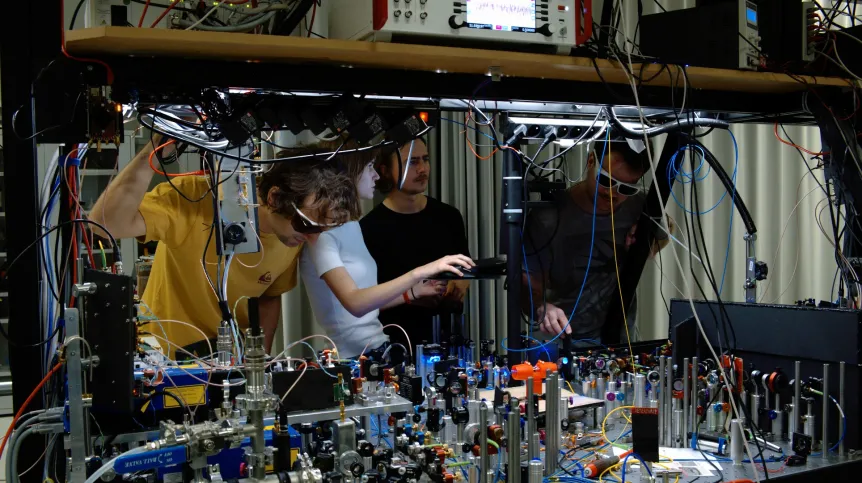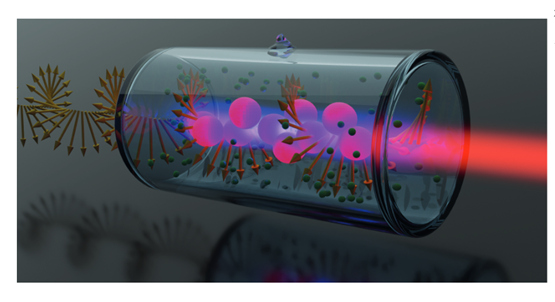
Researchers working at the QOT Centre for Quantum Optical Technologies created a device that 'translates' quantum information between microwave and optical photons. The new technique can be used in the quantum internet infrastructure and in microwave radio astronomy, report the representatives of the Faculty of Physics of the University of Warsaw.
The results of research on the device were published in Nature Photonics. The publication was the result of work in the team of the Laboratory of Quantum Optical Devices at the QOT Centre for Quantum Optical Technologies with the participation of doctoral student Sebastian Borówka, master's student Uliana Pylypenko, Dr. Mateusz Mazelanik and the head of the laboratory, Dr. Michał Parniak.
Microwaves converted into light
Whenever one listens to a song on a phone or computer, a conversion of information happens - a file digitally encoded in one’s device’s memory is converted to an electric current driving the headphones.
'Similarly, we can convert quantum information encoded in photons – the smallest quanta of light. For example, we can transfer information from a single microwave photon to a single optical photon,’ says Dr. Parniak
He adds that devices capable of single-photon operations are quite difficult to realise. They need to be very precise and introduce very little noise into the converted information. In addition, optical photons have energy ten thousand times larger than microwave photons and there are few media capable of simultaneously interacting with both species.
The conversion of quantum information is crucial for hybrid quantum networks that connect different quantum devices, such as quantum computers that compute using microwave photons interacting with superconducting circuits.
'The long-distance transfer of quantum information encoded in this manner poses a challenge due to the accumulation of noise. However, this is no longer a problem for optical photons, which can efficiently send quantum information via optical fibres. Therefore, the microwave-to-optical converter of quantum information can be a crucial part of a quantum network adapter - an interface between quantum computers and the quantum internet,’ explains Dr. Mateusz Mazelanik.
Atoms enlarged a thousand times
Scientists know that Rydberg atoms can interact both with microwave and optical photons. They can be produced via laser excitation of valence electrons e.g. in rubidium atoms. Thanks to this, the atom increases its size 1,000 times and acquires interesting properties that are the subject of research by many research groups around the world. In this case, the most important thing is that Rydberg atoms are very sensitive to microwave radiation.
So far, microwave-to-optical conversion has only been demonstrated in laser-cooled atoms caught in complex magneto-optical trapping setup. Scientists from the University of Warsaw are the first to show that microwave-to-optical conversion can be undertaken at room temperature, in atomic vapours inside a glass cell

'The proposed design of the converter is notably simpler and can be further miniaturised in the future. Additionally, the new conversion scheme shows very low noise levels and therefore can perform operations even on single photons. Even though the new converter setup is much simpler, the parameters of the conversion are surprisingly better. Our invention can work non-stop, as the atoms do not have to be prepared in a specially designed time sequence, which can take up more than 99% of the devices' operational time in experiments done by other groups,’ says the press release.
The converter device detected of microwave thermal radiation at room temperature without using microwave antennas or special low-noise amplifiers. The scientists emphasise that to get to the thermal level, the device has to be sensitive to single photons. Nevertheless, the converter can work for microwave radiation a million times stronger and cannot be damaged with even stronger fields.
Scientists know future applications
Members of the team that constructed the device explain that quantum technologies use various information carriers. Quantum computers based on superconducting junctions store their information in microwave frequencies, whereas quantum memories are largely based on optical photons.
Similarly to the quantum network adapter, the interconnection between the two types of devices requires an interface that can efficiently work both in microwave and optical domain. Rydberg atoms are one of the proposed solutions.
Operations on individual microwave photons may also be important for astronomical measurements examining the properties of distant objects or observing the early Universe, e.g. using microwave background radiation. Until now, measurements that retained the quantum information carried by microwave photons have not been possible. Microwave-optical conversion potentially creates room for a new branch of microwave radio astronomy.
According to researchers, everyday communication can also benefit from discoveries related to microwave detection. New generation mobile technologies use increasingly higher frequency microwave bands for transmission, which are increasingly difficult to produce and detect in electronic circuits. It may turn out at some point that atomic microwave sensors become a key element of these technologies, allowing, for example, to shorten the 'ping' to an absolute minimum.
Scientists at the QOT Centre for Quantum Optical Technologies and other research centres around the world are currently working on the use of quantum technologies in ultrasensitive microwave detection.
Find out more on this topic in the video material of the University of Warsaw.
PAP - Science in Poland
kol/ agt/ kap/
tr. RL













